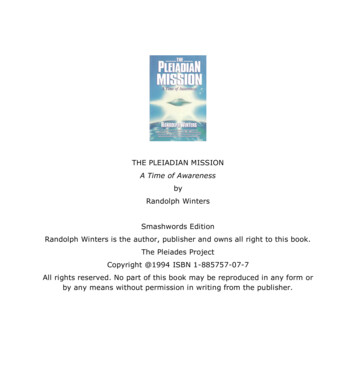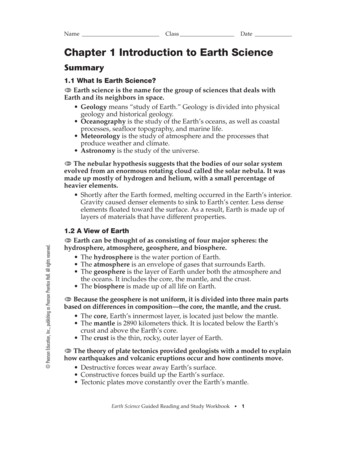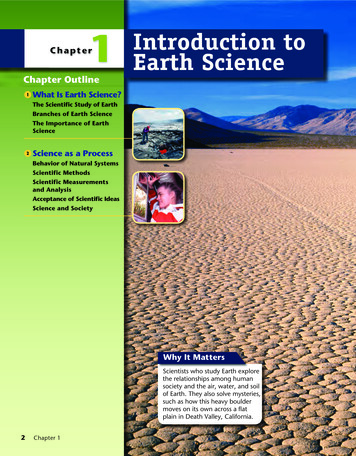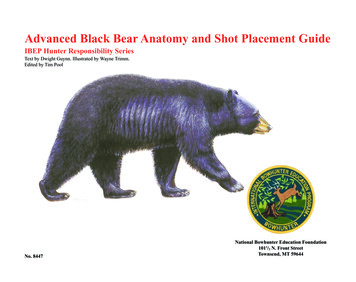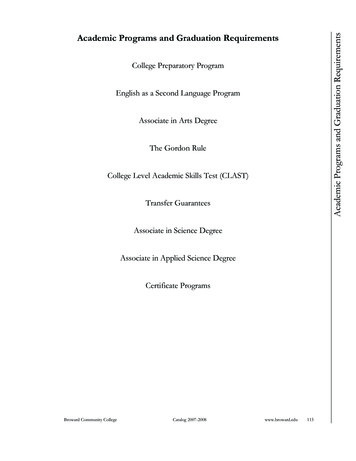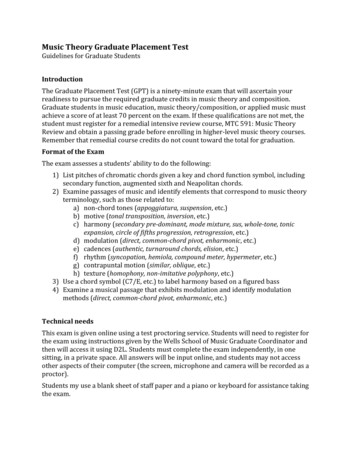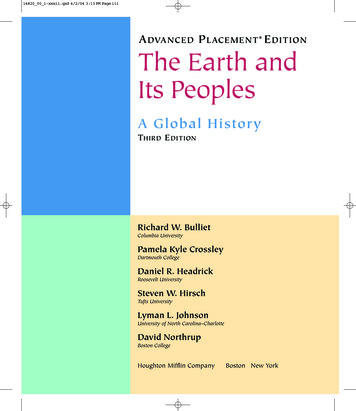
Transcription
14820 00 i-xxxii.qxd 4/2/04 3:13 PM Page iiiA DVANCED P LACEMENT* E DITIONThe Earth andIts PeoplesA Global HistoryTHIRD E DITIONRichard W. BullietColumbia UniversityPamela Kyle CrossleyDartmouth CollegeDaniel R. HeadrickRoosevelt UniversitySteven W. HirschTufts UniversityLyman L. JohnsonUniversity of North Carolina–CharlotteDavid NorthrupBoston CollegeHoughton Mifflin CompanyBoston New York
14820 00 i-xxxii.qxd 4/2/04 3:13 PM Page 7282930313233343536373839404142434445464748495051R 52L 53About the AuthorsRichard W. Bulliet Professor of Middle EasternHistory at Columbia University, Richard W. Bulliet received his Ph.D. from Harvard University. He has writtenscholarly works on a number of topics: the social historyof medieval Iran (The Patricians of Nishapur), the historical competition between pack camels and wheeledtransport (The Camel and the Wheel), the process of conversion to Islam (Conversion to Islam in the MedievalPeriod), and the overall course of Islamic social history(Islam: The View from the Edge). He is the editor of theColumbia History of the Twentieth Century. He has published four novels, co-edited The Encyclopedia of theModern Middle East, and hosted an educational television series on the Middle East. He was awarded a fellowship by the John Simon Guggenheim MemorialFoundation.Pamela Kyle CrossleyPamela Kyle Crossley received her Ph.D. in Modern Chinese History from YaleUniversity. She is Professor of History and Rosenwald Research Professor in the Arts and Sciences at DartmouthCollege. Her books include A Translucent Mirror: Historyand Identity in Qing Imperial Ideology; The Manchus;Orphan Warriors: Three Manchu Generations and theEnd of the Qing World; and (with Lynn Hollen Lees andJohn W. Servos) Global Society: The World Since 1900. Herresearch, which concentrates on the cultural history ofChina, Inner Asia, and Central Asia, has been supportedby the John Simon Guggenheim Memorial Foundationand the National Endowment for the Humanities.Daniel R. Headrick Daniel R. Headrick receivedhis Ph.D. in History from Princeton University. Professorof History and Social Science at Roosevelt University inChicago, he is the author of several books on the historyof technology, imperialism, and international relations,including The Tools of Empire: Technology and EuropeanImperialism in the Nineteenth Century; The Tentacles ofProgress: Technology Transfer in the Age of Imperialism;The Invisible Weapon: Telecommunications and International Politics; and When Information Came of Age:Technologies of Knowledge in the Age of Reason and Revolution, 1700–1850. His articles have appeared in theJournal of World History and the Journal of Modern History, and he has been awarded fellowships by the National Endowment for the Humanities, the John SimonGuggenheim Memorial Foundation, and the Alfred P.Sloan Foundation.xxviii1ST PASS PAGESSteven W. Hirsch Steven W. Hirsch holds a Ph.D. inClassics from Stanford University and is currently Associate Professor Classics and History at Tufts University.He has received grants from the National Endowmentfor the Humanities and the Massachusetts Foundationfor Humanities and Public Policy. His research and publications include The Friendship of the Barbarians:Xenophon and the Persian Empire, as well as articles andreviews in the Classical Journal, the American Journal ofPhilology, and the Journal of Interdisciplinary History. Heis currently working on a comparative study of ancientMediterranean and Chinese civilizations.Lyman L. Johnson Professor of History at the University of North Carolina at Charlotte, Lyman L. Johnsonearned his Ph.D. in Latin American History from theUniversity of Connecticut. A two-time Senior FulbrightHays Lecturer, he also has received fellowships from theTinker Foundation, the Social Science Research Council,the National Endowment for the Humanities, and theAmerican Philosophical Society. His recent books include Death, Dismemberment, and Memory; The Facesof Honor (with Sonya Lipsett-Rivera); The Problem ofOrder in Changing Societies; Essays on the Price Historyof Eighteenth-Century Latin America (with EnriqueTandeter); and Colonial Latin America (with Mark A.Burkholder). He also has published in journals, including the Hispanic American Historical Review, the Journalof Latin American Studies, the International Review ofSocial History, Social History, and Desarrollo Económico.He recently served as president of the Conference onLatin American History.David Northrup Professor of History at Boston College, David Northrup earned his Ph.D. in African and European History from the University of California at LosAngeles. He earlier taught in Nigeria with the Peace Corpsand at Tuskegee Institute. Research supported by theFulbright-Hays Commission, the National Endowmentfor the Humanities, and the Social Science ResearchCouncil led to publications concerning pre-colonialNigeria, the Congo (1870–1940), the Atlantic slave trade,and Asian, African, and Pacific Islander indentured laborin the nineteenth century. A contributor to the OxfordHistory of the British Empire and Blacks in the BritishEmpire, his latest book is Africa’s Discovery of Europe,1450–1850. For 2004 and 2005 he serves as president ofthe World History Association.
14820 00 i-xxxii.qxd 4/2/04 3:13 PM Page 930313233343536373839404142434445464748495051R 52L 53Document-Based Questions: Bard KeelerPublisher: Charles HartfordEditor-in-Chief: Jean L. WoySenior Sponsoring Editor: Nancy BlaineSenior Development Editor: Jennifer SutherlandEditorial Associate: Annette FantasiaSenior Project Editor: Carol NewmanEditorial Assistant: Trinity Peacock-BroylesSenior Design Coordinator: Jill HaberSenior Designer: Henry RachlinManufacturing Manager: Florence CadranSenior Marketing Manager: Sandra McGuireCover illustration: New Year’s Festival (woodcut) by Utagawa Kunisada (1786–1864) Victoria and Albert Museum, London, UK / Bridgeman Art Library International, Ltd.Part opener credits: Pt. 1, p. 1: Gian Berto Vanni/Corbis; Pt. 2, p. 89: Corbis; Pt. 3, p. 193: TokyoNational Museum/DNP Archives; Pt. 4, p. 291: Bibliothèque nationale de France; Pt. 5, p. 401: Libraryof Congress; Pt. 6, p. 537: Hulton-Deutsch/Corbis; Pt. 7, p. 677: Charles O’Rear/Corbis; Pt. 8, p. 817 Corbis.Chapter opener credits: Ch. 1, p. 4: Giraudon/Art Resource, NY; Ch. 2, p. 36: Courtesy of theTrustees of the British Museum; Ch. 3, p. 59: Woodfin Camp & Associates; Ch. 4, p. 92: Bibliotèque nationale de France; Ch. 5, p. 123: Dennis Cox/ChinaStock; Ch. 6, p. 150: Dinodia Photo Library; Ch.7, p. 173: Allan Eaton/Ancient Art & Architecture; Ch. 8, p. 196: Suleymaniye Library, Istanbul. Courtesy, Karen Pinto, History Department, Columbia University; Ch. 9, p. 218: Musée de Bayeaux/Michael Holford; Ch. 10, p. 248: Fujita Art Museum; Ch. 11, p. 267: Justin Kerr; Ch. 12, p. 294: ImperialHousehold Agency/International Society for Educational Information, Japan; Ch. 13, p. 324: ImperialHousehold Collection, Kyoto; Ch. 14, p. 349: Copyright Brussels, Royal Library of Belgium; Ch. 15, p.375: G. Dagli Orti/The Art Archive; Ch. 16, p. 404: Kunsthistorisches Museum, Vienna/The BridgemanArt Library, New York and London; Ch. 17, p. 430: Archivo General de la Nación, Buenos Aires; Ch. 18,p. 457: From William Clark, Ten Views in the Islands of Antigua, 1823. British Library; Ch. 19, p. 484:V&A Picture Library; Ch. 20, p. 510: Novosti; Ch. 21, p. 540: Jean-Loup Charmet/ The Bridgeman ArtLibrary; Ch. 22, p. 568: Science & Society Picture Library; Ch. 23, p. 592: Estación de Orizaba, 1877.From Casimiro Castro, Album del Ferro-Carril Mexicano: Coleccion de Vista Pintadas (Victor Debrayand Company, 1877); Ch. 24, p. 623: Eyre and Hobbs House Art Gallery; Ch. 25, p. 650: Mary Evans Picture Library; Ch. 26, p. 680: The Metropolitan Museum of Art, gift of Lincoln Kirstein, 1959 (JP 3346).Photograph by Otto E. Nelson. Photograph 1986 The Metropolitan Museum of Art; Ch. 27, p. 707:Bildarchiv Preussischer Kulturbesitz; Ch. 28, p. 735: Imperial War Museum/The Art Archive; Ch. 29, p.765: akg-images; Ch. 30, p. 793: Genevieve Naylor, photographer/Reznikoff Artistic Partnership, NY;Ch. 31, p. 820: Bettmann/Corbis; Ch. 32, p. 847: Paul Chesley/Getty Images; Ch. 33, p. 878: AFP Photo/Doug Kanter/Getty Images.*“Advanced Placement” and “AP” are registered trademarks of the College Board, which isnot involved in the production of, and does not endorse, this product.Copyright 2005 by Houghton Mifflin Company. All rights reserved.No part of this work may be reproduced or transmitted in any form or by any means, electronic ormechanical, including photocopying and recording, or by any information storage or retrieval system without the prior written permission of Houghton Mifflin Company unless such copying is expressly permitted by federal copyright law. Address inquiries to College Permissions, HoughtonMifflin Company, 222 Berkeley Street, Boston, MA 02116-3764.Printed in U.S.A.Library of Congress Catalog Card Number: 2003113993ISBN: 0-618-42770-81 2 3 4 5 6 7 8 9—DW—2008 2007 2006 2005 2004ROUGH PAGES
14820 PO1 001-003 r2ws.qxd 4/2/04 8:15 PM Page 1PART ONEThe Emergence ofHuman Communities,to 500 B.C.E.CHAPTER 1From the Originsof Agriculture to the FirstRiver-Valley Civilizations,8000–1500 B.C.E.CHAPTER 2New Civilizations in theEastern and WesternHemispheres, 2200–250 B.C.E.CHAPTER 3The Mediterranean andMiddle East, 2000–500 B.C.E.Around 10,000 years ago, some human groups in various parts of theworld began to cultivate plants, domesticate animals, and make potteryvessels for storage. One consequence of this shift from hunting and gathering to agriculture was the emergence of permanent settlements—at firstsmall villages but eventually larger towns as well.The earliest complex societies arose in the great river valleys of Asia andAfrica, around 3100 B.C.E. in the valley between the Tigris and EuphratesRivers in Mesopotamia and along the Nile River in Egypt, somewhat later inthe valley of the Indus River in Pakistan, and on the floodplain of the YellowRiver in China. In these arid regions, agriculture depended on irrigation withriver water, and centers of political power arose to organize the massive human labor required to dig and maintain channels to carry water to the fields.Kings and priests dominated these early societies. Kings controlledthe military forces; priests managed the temples and the wealth of the gods.Within the urban centers—in the midst of palaces, temples, fortificationwalls, and other monumental buildings—lived administrators, soldiers, priests,merchants, craftsmen, and others with specialized skills. The production ofsurplus food grown on rural estates by a dependent peasantry sustained the activities of these groups. Professional scribes kept administrative and financialrecords and preserved their civilization’s religious and scientific knowledge.1
14820 PO1 001-003 r2ws.qxd 4/2/04 8:15 PM Page 930313233343536373839404142434445464748495051R 52L 53Over time, certain centers extended their influence and came to dominate broad expansesof territory. The rulers of these early empireswere motivated primarily by the need to secureaccess to raw materials, especially tin and copper,from which to make bronze. A similar motive accountsfor the development of long-distance trade and diplomaticrelations between major powers. Fueling long-distance tradewas the desire for bronze, which had both practical and symbolic importance. From bronze, artisans made weapons, toolsand utensils, and ritual objects. Ownership of bronze items wasa sign of wealth and power. Trade and diplomacy helped spreadculture and technology from the core river-valley areas to neighboring regions, such as southern China, Nubia, Syria-Palestine,Anatolia, and the Aegean.In the Western Hemisphere, different geographical circumstances called forth distinctive patterns of technological and culturalresponse in the early civilizations of the Olmec in southern Mexico andChavín in the Andean region of South America. Nevertheless, the challengesof organizing agriculture and trade led to many of the same features of complex societies—social stratification, specialization of labor, urbanization,monumental building, technological development, and artistic achievement.ROUGH PAGES
14820 01 04-35 r2ek.qxd 4/2/04 3:15 PM Page 41From the Origins ofAgriculture to the FirstRiver-Valley Civilizations8000–1500 B.C.E.CHAPTER OUTLINEBefore CivilizationMesopotamiaEgyptThe Indus Valley CivilizationDIVERSITY AND DOMINANCE: Violence and Order in the Babylonian New Year’s FestivalENVIRONMENT AND TECHNOLOGY: Environmental Stress in the Indus Valley4
14820 01 04-35 r2ek.qxd 4/2/04 3:15 PM Page 5Some five thousand years ago in Mesopotamia(present-day Iraq), people living in Sumer, theworld’s first urban civilization, cherished the story ofGilgamesh, superhero king of the city of Uruk. Thegoddess of creation, it recounted, fashioned the wildman Enkidu :There was virtue in him of the god of war, of Ninurta himself. His body was rough, he had longhair like a woman’s; it waved like the hair of Nisaba, the goddess of corn. His body was coveredwith matted hair like Samuqan’s, the god of cattle. He was innocent of mankind; he knew nothing of the cultivated land. Enkidu ate grass in thehills with the gazelle and jostled with the wildbeasts at the water-holes; he had joy of the waterwith the herds of wild game.When Gilgamesh learns of Enkidu from a hunter,he sends a temple prostitute to tame him. After her seduction causes the wild beasts to shun him, she says:Come with me. I will take you to strong-walledUruk, to the blessed temple of Ishtar and of Anu,of love and of heaven . . . there all the people aredressed in their gorgeous robes, every day is holiday, the young men and the girls are wonderfulto see. How sweet they smell! . . . O Enkidu, youwho live life, I will show you Gilgamesh.1She clothes Enkidu and teaches him to eat cookedfood, drink beer, and bathe and oil his body. Herwords and actions signal the principal traits of civilized life in Sumer, just as the divine comparisons ofthe wild Enkidu show Sumer’s dependence on grainand livestock.The Sumerians, like other peoples, equated civilization with their own way of life. But lifestyles varied.Given the ambiguity of the term civilization, therefore, the common understanding that the first civi-Enkidu (EN-kee-doo)Uruk (OO-rook)lizations arose in Mesopotamia and Egypt sometimebefore 3000 B.C.E. needs examination.Scholars agree that settled agricultural life andcertain political, social, economic, and technologicaltraits are indicators of civilization, if not of every civilization. These traits include (1) cities as administrative centers, (2) a political system based on definedterritory rather than kinship, (3) many people engaged in specialized, non-food-producing activities,(4) status distinctions based largely on accumulationof wealth, (5) monumental building, (6) a system forkeeping permanent records, (7) long-distance trade,and (8) sophisticated interest in science and art.The earliest societies exhibiting these traits appeared in the floodplains of great rivers: the Tigris and Euphrates in Iraq, the Indus in Pakistan, the Yellow (Huang He ) in China, and the Nile in Egypt (seeMap 1.2). Periodic flooding fertilized the land with siltand provided water for agriculture but also threatenedlives and property. To control the floods, the peoplesliving near the rivers created new technologies andforms of political and social organization.In this chapter, we describe the origins of domestication among the scattered groups of foragers livingat the end of the last Ice Age and the slow developmentof farming and herding societies. We then trace the riseof complex societies in Mesopotamia, Egypt, and theIndus River Valley from approximately 3500 to 1500B.C.E. (China, developing slightly later, is discussed inChapter 2). This story roughly coincides with the origins of writing, allowing us to document aspects ofhuman life not revealed by archaeological evidencealone.As you read this chapter, ask yourself the following questions: How did plant and animal domestication set thescene for the emergence of civilization? Why did the earliest civilizations arise in river valleys?Tigris (TIE-gris) Euphrates (you-FRAY-teez)Huang He (hwang huh)52nd Pass 28293031323334353637383940414243444546474849505152 R53 L
14820 01 04-35 r2ek.qxd 4/2/04 3:15 PM Page 930313233343536373839404142434445464748495051R 52L 53Chapter 1From the Origins of Agriculture to the First River-Valley Civilizations, 8000–1500 b.c.e. How did the organization of labor shape politicaland social structures? How did metallurgy, writing, and monumental construction contribute to the power and wealth ofelite groups? How do religious beliefs reflect interaction with theenvironment?BEFORE CIVILIZATIONEvidence of human artistic creativity first came to lightin 1940 near Lascaux in southwestern France with thediscovery of a vast underground cavern. The cavern wallswere covered with paintings of animals, including manythat had been extinct for thousands of years. Similar cavepaintings have been found in Spain and elsewhere insouthern France.To even the most skeptical person, these artistictroves reveal rich imaginations and sophisticated skills,qualities also apparent in the stone tools and evidence ofcomplex social relations uncovered from prehistoricsites. The production of such artworks and tools overwide areas and long periods of time demonstrates thatskills and ideas were not simply individual but were deliberately passed along within societies. These learnedpatterns of action and expression constitute culture. Culture includes material objects, such as dwellings, clothing, tools, and crafts, along with nonmaterial values,beliefs, and languages. Although it is true that some animals also learn new ways, their activities are determinedprimarily by inherited instincts. Only human communities trace profound cultural developments over time.The development, transmission, and transformation ofcultural practices and events are the subject of history.Stone toolmaking, the first recognizable cultural activity, firstappeared around 2 millionyears ago. The Stone Age, whichlasted from then until around4,000 years ago, can be a misleading label. Stone toolsabound at archaeological sites, but not all tools were ofstone. They were made as well of bone, skin, and wood,materials that survive poorly. In addition, this periodencompasses many cultures and subperiods. Amongthe major subdivisions, the Paleolithic (Old Stone Age)Food Gatheringand StoneTechnologyPaleolithic (pay-lee-oh-LITH-ik)2nd Pass Pageslasted until 10,000 years ago, about 3,000 years after theend of the last Ice Age, long periods when glaciers covered much of North America, Europe, and Asia. The Neolithic (New Stone Age), which is associated with theorigins of agriculture, followed.Fossilized animal bones bearing the marks of butchering tools testify to the scavenging and hunting activities of Stone Age peoples, but anthropologists do notbelieve that early humans lived primarily on meat. Modern foragers (hunting and food-gathering peoples) inthe Kalahari Desert of southern Africa and Ituri Forest ofcentral Africa derive the bulk of their day-to-day nourishment from wild vegetable foods. They eat meat atfeasts. Stone Age peoples probably did the same, eventhough the tools and equipment for gathering and processing vegetable foods have left few archaeologicaltraces.Like modern foragers, ancient humans would haveused skins and mats woven from leaves for collectingfruits, berries, and wild seeds, and they would have dugup edible roots with wooden sticks. Archaeologists suspect that the doughnut-shaped stones often found atStone Age sites served as weights to make wooden digging sticks more effective.Cooking makes both meat and vegetables tastierand easier to digest, something early humans may havediscovered inadvertently after wildfires. Humans mayhave begun setting fires deliberately 1 million to 1.5 million years ago, but proof of cooking does not appear until some 12,500 years ago, when clay cooking pots cameinto use in East Asia.Studies of present-day foragers also indicate that IceAge women probably did most of the gathering and cooking, which they could do while caring for small children.Women past child-bearing age would have been the mostknowledgeable and productive food gatherers. Men, withstronger arms and shoulders, would have been bettersuited for hunting, particularly for large animals. Someearly cave art suggests male hunting activities.The same studies, along with archaeological evidence from Ice Age campsites, indicate that early foragers lived in groups that were big enough to defendthemselves from predators and divide responsibility forfood collection and preparation, but small enough notto exhaust the food resources within walking distance.Even bands of around fifty men, women, and childrenwould have moved regularly to follow migrating animalsor collect seasonally ripening plants in different places.In regions with severe climates or lacking in naturalshelters like caves, people built huts of branches, stones,Neolithic (nee-oh-LITH-ik)
14820 01 04-35 r2ek.qxd 4/2/04 3:15 PM Page 7Before CivilizationCHRONMesopotamiaOLOEgyptG7YIndus Valley3500 B.C.E.3100–2575 B.C.E.Early Dynastic3000 B.C.E.3000–2350 B.C.E.Early Dynastic (Sumerian)2575–2134 B.C.E.Old Kingdom2600 B.C.E. Beginning ofIndus Valley civilization2500 B.C.E.2350–2230 B.C.E.Akkadian (Semitic)2000 B.C.E.2112–2004 B.C.E.Third Dynasty of Ur (Sumerian)1900–1600 B.C.E.Old Babylonian (Semitic)2134–2040 B.C.E.First Intermediate Period2040–1640 B.C.E.Middle Kingdom1900 B.C.E. End of IndusValley civilization1640–1532 B.C.E.Second Intermediate Period1532–1070 B.C.E.New Kingdom1500 B.C.E.1500–1150 B.C.E.Kassitebones, skins, and leaves as seasonal camps. Animal skinsserved as clothing, with the earliest evidence of wovencloth appearing about 26,000 years ago. Groups living inthe African grasslands and other game-rich areas probably spent only three to five hours a day securing food,clothing, and shelter. This would have left a great deal oftime for artistic endeavors, tool-making, and social life.The foundations of what later ages called science,art, and religion also date to the Stone Age. Gathererslearned which local plants were edible and when theyripened, as well as which natural substances were effective for medicine, consciousness altering, dyeing, andother purposes. Hunters learned the habits of game animals. People experimented with techniques of usingplant and animal materials for clothing, twine, and construction. Knowledge of the environment included identifying which minerals made good paints and whichstones made good tools. All of these aspects of culturewere passed orally from generation to generation.Early music and dance have left no traces, but visualartwork has survived abundantly. Cave paintings appearas early as 32,000 years ago in Europe and North Africaand somewhat later in other parts of the world. Becausemany feature food animals like wild oxen, reindeer, andhorses, some scholars believe the art records huntingscenes or played a magical and religious role in hunting.A newly discovered cave at Vallon Pont-d’Arc in southern France, however, features rhinoceros, panthers, bears,owls, and a hyena, which probably were not hunted forfood. Other drawings include people dressed in animalskins and smeared with paint and stencils of humanhands. Some scholars suspect that other marks in cavepaintings and on bones may represent efforts at counting or writing.Some cave art suggests that Stone Age people hadwell-developed religions, but without written texts, it ishard to know what they believed. Some graves fromabout 100,000 years ago contain stone implements, food,clothing, and red-ochre powder, indicating that earlypeople revered their leaders enough to honor them indeath and may have believed in an afterlife.Around 10,000 years ago, somehuman groups began to meettheir food needs by raising domesticated plants and animals.Gradually over the next millennium, most people became food producers, although hunting and gatheringcontinued in some places.The AgriculturalRevolutionsVallon Pont-d’Arc (vah-LON pon-DAHRK)2nd Pass 28293031323334353637383940414243444546474849505152 R53 L
14820 01 04-35 r2ek.qxd 4/2/04 3:15 PM Page 930313233343536373839404142434445464748495051R 52L 53Chapter 1From the Origins of Agriculture to the First River-Valley Civilizations, 8000–1500 b.c.e.The term Neolithic Revolution, commonly given tothe changeover from food gathering to food producing,can be misleading. Neolithic means “new stone,” but thenew tool designs that accompanied the beginnings ofagriculture did not define it. Nor was the “revolution” asingle event. The changeover occurred at different timesin different parts of the world. The term AgriculturalRevolutions is more precise because it emphasizes thecentral role of food production and signals that thechangeover occurred several times. The adoption of agriculture often included the domestication of animals forfood (see Map 1.1).Food gathering gave way to food production overhundreds of generations. The process may have begunwhen forager bands, returning year after year to thesame seasonal camps, scattered seeds and cleared awayweeds to encourage the growth of foods they liked. Suchsemicultivation could have supplemented food gathering without the permanent settlement of the group.Families choosing to concentrate their energies on foodproduction, however, would have had to settle permanently near their fields.Specialized stone tools first alerted archaeologists tonew food-producing practices: polished or ground stoneheads to work the soil, sharp stone chips embedded inbone or wooden handles to cut grasses, and stone mortars to pulverize grain. Early farmers used fire to clearfields of shrubs and trees and discovered that asheswere a natural fertilizer. After the burn-off, farmers usedblades and axes to keep the land clear.Selection of the highest-yielding strains of wildplants led to the development of domesticated varietiesover time. As the principal gatherers of wild plant foods,women probably played a major role in this transition toplant cultivation, but the task of clearing fields probablyfell to the men.In the Middle East, the region with the earliest evidence of agriculture, human selection had transformedcertain wild grasses into higher-yielding domesticatedgrains, now known as emmer wheat and barley, by8000 B.C.E. Farmers there also discovered that alternatingthe cultivation of grains and pulses (plants yieldingedible seeds such as lentils and peas) helped maintainfertility.Plants domesticated in the Middle East spread to adjacent lands, but in many parts of the world, agriculturearose independently. Exchanges of crops and techniquesoccurred between regions, but societies that had alreadyturned to farming borrowed new plants, animals, andfarming techniques more readily than foraging groupsdid.The eastern Sahara, which went through a wet period after 8000 B.C.E., preserves the oldest traces of food2nd Pass Pagesproduction in northern Africa. As in the Middle East,emmer wheat and barley became the principal cropsand sheep, goats, and cattle the main domestic animals.When drier conditions returned around 5000 B.C.E.,many Saharan farmers moved to the Nile Valley, wherethe river’s annual flood provided water for crops.In Greece, wheat and barley cultivation, beginningas early as 6000 B.C.E., combined local experiments withMiddle Eastern borrowings. Shortly after 4000 B.C.E.,farming developed in the light-soiled plains of CentralEurope and along the Danube River. As forests recededbecause of climate changes and human clearing efforts,agriculture spread to other parts of Europe over the nextmillennium.Early farmers in Europe and elsewhere practicedshifting cultivation, also known as swidden agriculture.After a few growing seasons, farmers left the fields fallow (abandoned to natural vegetation) and cleared newfields nearby. Between 4000 and 3000 B.C.E., for example,communities of from forty to sixty people in the DanubeValley supported themselves on about 500 acres (200hectares) of farmland, cultivating a third or less eachyear while leaving the rest fallow to regain its fertility.From around 2600 B.C.E., people in Central Europe beganusing ox-drawn wooden plows to till heavier and richersoils.Although the lands around the Mediterranean seemto have shared a complex of crops and farming techniques, geographical barriers blocked the spread elsewhere. Rainfall patterns south of the Sahara favoredlocally domesticated grains—sorghums, millets, and (in
14820 01 04-35 r2ek.qxd 4/2/04 3:15 PM Page 9Before 49505152 R53 L2nd Pass Pages
14820 01 04-35 r2ek.qxd 4/2/04 3:15 PM Page 82930313233343536373839404142434445464748495051R 52L 53Chapter 1From the Origins of Agriculture to the First River-Valley Civilizations, 8000–1500 b.c.e.Ethiopia) teff—over wheat and barley. Middle Easterngrains did not grow at all in the humidity of equatorialWest Africa; there, yams became an early domestic crop.Domestic rice originated in southern China, thenorthern half of Southeast Asia, or northern India, possibly as early as 10,000 B.C.E. but more likely closer to 5000B.C.E. The w
History of the British Empire and Blacks in the British Empire, his latest book is Africa’s Discovery of Europe, 1450–1850. For 2004 and 2005 he serves as president of the World History Association. About th


